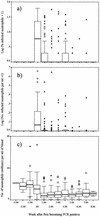Transmission of Anaplasma phagocytophilum to Ixodes ricinus ticks from sheep in the acute and post-acute phases of infection
- PMID: 12654828
- PMCID: PMC152096
- DOI: 10.1128/IAI.71.4.2071-2078.2003
Transmission of Anaplasma phagocytophilum to Ixodes ricinus ticks from sheep in the acute and post-acute phases of infection
Abstract
A total of 60 sheep were exposed to Anaplasma phagocytophilum infection on an enclosed area of Ixodes ricinus-infested pasture in North Wales, United Kingdom, and rapidly acquired acute A. phagocytophilum infections detectable by PCR and blood smear examination. Of the ticks that had engorged in the previous instar on infected sheep, 52% of adult ticks and 28% of nymphs were PCR positive; a significant, 10-fold increase in prevalence compared to that of ticks that engorged on sheep preinfection was observed (P = 0.015). The likelihood that ticks were PCR positive, after feeding on the sheep and molting to the next instar, increased marginally with increasing numbers of infected neutrophils per milliliter of blood of their sheep host (P = 0.068) and increased significantly when they were collected from sheep carrying higher numbers of adult female ticks (P = 0.017), but increasing numbers of feeding nymphs had a significant negative effect on transmission (P = 0.049). The numbers of circulating neutrophils and of infected neutrophils also varied significantly with the numbers of ticks feeding on the sheep when the blood was collected. Our study suggests that ruminants are efficient reservoirs of A. phagocytophilum during the acute and post-acute phases of infection. The risk of ruminant-derived infections may, however, be strongly affected by variations in tick densities, which may influence transmission from acutely infected animals via effects on the numbers of infected cells in the blood and possibly by within-skin modulation of infection.
Figures




Similar articles
-
Molecular evidence for Anaplasma phagocytophilum in Ixodes ricinus ticks from Greece.Vector Borne Zoonotic Dis. 2011 Oct;11(10):1391-3. doi: 10.1089/vbz.2010.0251. Epub 2011 Sep 16. Vector Borne Zoonotic Dis. 2011. PMID: 21923272
-
Prevalence of Anaplasma phagocytophilum in Ixodes ricinus in Bavarian public parks, Germany.Ticks Tick Borne Dis. 2011 Dec;2(4):196-203. doi: 10.1016/j.ttbdis.2011.09.009. Epub 2011 Oct 22. Ticks Tick Borne Dis. 2011. PMID: 22108012
-
Molecular detection of Anaplasma phagocytophilum in Ixodid ticks in Hebei Province, China.Vector Borne Zoonotic Dis. 2011 Oct;11(10):1323-7. doi: 10.1089/vbz.2010.0253. Epub 2011 Sep 16. Vector Borne Zoonotic Dis. 2011. PMID: 21923254
-
A review of studies on the transmission of Anaplasma phagocytophilum from sheep: implications for the force of infection in endemic cycles.Exp Appl Acarol. 2002;28(1-4):195-202. doi: 10.1023/a:1025394315915. Exp Appl Acarol. 2002. PMID: 14570131 Review.
-
[Ixodes ricinus, transmitted diseases and reservoirs].Parassitologia. 2004 Jun;46(1-2):119-22. Parassitologia. 2004. PMID: 15305699 Review. Italian.
Cited by
-
Spread of ticks and tick-borne diseases in Germany due to global warming.Parasitol Res. 2008 Dec;103 Suppl 1:S109-16. doi: 10.1007/s00436-008-1059-4. Epub 2008 Nov 23. Parasitol Res. 2008. PMID: 19030892
-
First Molecular Evidence for the Presence of Anaplasma phagocytophilum in Naturally Infected Small Ruminants in Tunisia, and Confirmation of Anaplasma ovis Endemicity.Pathogens. 2022 Mar 3;11(3):315. doi: 10.3390/pathogens11030315. Pathogens. 2022. PMID: 35335639 Free PMC article.
-
Variant -and individual dependent nature of persistent Anaplasma phagocytophilum infection.Acta Vet Scand. 2010 Apr 15;52(1):25. doi: 10.1186/1751-0147-52-25. Acta Vet Scand. 2010. PMID: 20398321 Free PMC article.
-
Experimental Infection of Mice and Ticks with the Human Isolate of Anaplasma phagocytophilum NY-18.Pathogens. 2022 Jul 21;11(7):820. doi: 10.3390/pathogens11070820. Pathogens. 2022. PMID: 35890063 Free PMC article.
-
Experimental Ixodes ricinus-Sheep Cycle of Anaplasma phagocytophilum NV2Os Propagated in Tick Cell Cultures.Front Vet Sci. 2020 Feb 6;7:40. doi: 10.3389/fvets.2020.00040. eCollection 2020. Front Vet Sci. 2020. PMID: 32118063 Free PMC article.
References
-
- Abdul-Amir, I. M., and J. S. Gray. 1987. Resistance of sheep to laboratory infestations of the tick Ixodes ricinus. Res. Vet. Sci. 43:266-267. - PubMed
-
- Bjoersdorff, A., L. Svendenius, J. H. Owens, and R. F. Massung. 1999. Feline granulocytic ehrlichiosis—a report of a new clinical entity and characterisation of the infectious agent. J. Small Anim. Pract. 40:20-24. - PubMed
-
- Castro, M. B., W. L. Nicholson, V. L. Kramer, and J. E. Childs. 2001. Persistent infection in Neotoma fuscipes (Muridae: Sigmodontinae) with Ehrlichia phagocytophila sensu lato. Am. J. Trop. Med. Hyg. 65:261-267. - PubMed
Publication types
MeSH terms
Substances
Associated data
- Actions
- Actions
- Actions
- Actions
LinkOut - more resources
Full Text Sources
Molecular Biology Databases

